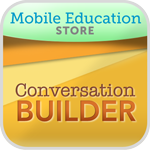iEAR.org is the premier website to find out about he best education apps on iTunes. Emily Church is a SLP who found my ConversationBuildersocial skills app and has used it regularly with many of her students. This is by far the most comprehensive review of ANY of my speech apps. She writes:
The innovative interface of Conversation Builder mimics the pattern of natural conversation, using a visual and auditory format proven effective for teaching children with ASD. The flow back-and-forth between responses is incredibly intuitive and natural, keeping the student utterly engaged while providing just the right amount of feedback and encouragement to guide them throughout.
One of the things I love best about Conversation Builder is that sometimes the choices of responses provide some “gray area.” By this, I mean that of the 3 choices, more than one may on the surface seem good or polite, but—based on the context of the situation and the purpose of the interaction—they are not the best choice. For our kids, this is essential! Most students with ASD have been conditioned for certain types of “correct” responses. They have memorized our lessons on staying on topic and avoiding rude or unkind comments. However, in a real conversation, the best response is not simply “polite” or “on-topic.” The best response is relevant to the situation and to the speaker’s intent, engaging the listener and encouraging a response. Conversation is built on intent. If your intent is to play with a group of children, a peripherally related comment on what they are doing will not lead to them asking you to join their game.
Conversation Builder gives us a chance to address the more complex nuances of conversation, to pause and discuss, review and reflect. To go beyond the basics. This is something that, in my opinion, has never been done before.
the issue of social conversation goes beyond a lack of opportunity or simply needing more practice. Faced with a person-to-person encounter, there are a multitude of factors that interfere with a child with ASD’s ability to focus on the actual elements and flow of conversation: social anxiety, hypersensitivity to visual input—e.g., eye contact—and an overwhelming fear of being wrong. Say the wrong thing to an adult and you may get in trouble. Say the wrong thing to a peer and they’re likely to laugh in your face or call you a name or take their lunch tray to another table, permanently. To put it bluntly: If children with Autism Spectrum Disorders could learn how to communicate like their peers simply from being around their peers, it wouldn’t be a disorder.
That is why this app is so amazing. It lets a child with a social communication disorder work on the actual components of communication, separate from the anxiety and pressure induced by facing a human partner. Lets them have a minute to put a conversation on pause and think about what they want to say, without the distraction of sensing another’s real or imagined impatience or disapproval. Lets them experience the back and forth pattern of real conversations in a format they can manipulate. Lets them fix communication errors independently and rerecord misspoken responses. It not quite real life and because of this we are given multiple opportunities to teach, examine, and correct conversational skills in ways we could not do otherwise.
This author really understands what I was trying to accomplish with the application. It is a long review, but I HIGHLY encourage everyone to read it through. You will find no better description of how it works than this review.
Tap on the icon below to find out more about ConversationBuilder and purchase it on iTunes!
